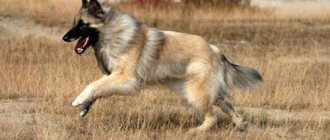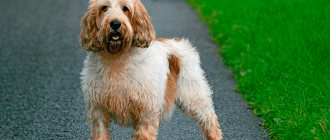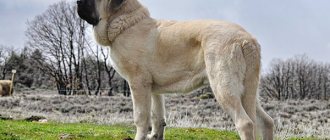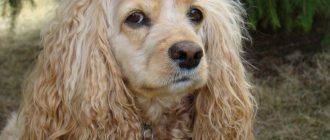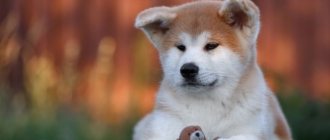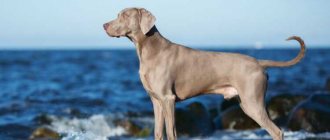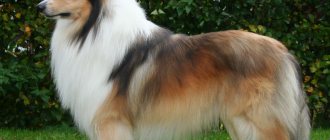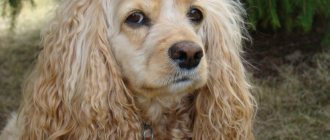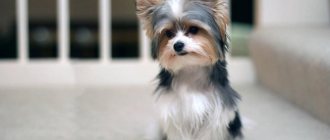The Basset Hound is an amazing dog with a clumsy gait and sad eyes. Thanks to her easy-going character and memorable appearance, she is popular all over the world. The breed was bred for hunting and is classified as a hound. But now Basset Hounds live in the house, they are wonderful companions and caring nannies. These dogs are smart, friendly, unpretentious. And thanks to their medium size, they are ideal for keeping in a city apartment or private house. The breed has many fans all over the world. But before you get a Basset Hound puppy for the first time, you need to understand the features, learn about the pros and cons of these dogs, and study the prices.
- Head
- Upbringing
- Care
Breed traits
Breed traits (on a 5-point scale)
| Basset Hound | |||
| Activity | in the house | 2.3 | |
| on the street | 3.3 | ||
| Obedience | training | 2.3 | |
| strangers | 2.9 | ||
| Domination | in family | 2.1 | |
| over dogs | 2 | ||
| Defending your territory | from people | 2.1 | |
| from dogs | 2.3 | ||
| Sociability | in family | 4.5 | |
| with strangers | 3.9 | ||
| with dogs | 3.6 | ||
| Concentration | in family | 1.9 | |
| in front of strangers | 2.3 | ||
| with dogs | 2.8 | ||
| Aggressiveness | in family | 1.4 | |
| to strangers | 1.7 | ||
| to the dogs | 1.8 | ||
| to cats | 1.8 | ||
| Family behavior | calmness | 2.8 | |
| demand for affection | 4.2 | ||
| excitability | 3 | ||
| playfulness | 3.8 | ||
| excessive barking | 3.2 | ||
| behavioral breakdowns | 2.2 | ||
| Tolerance for children | up to 4 years | 3.8 | |
| over 4 years old | 4.2 | ||
| Institutional use | watchman | 3.8 | |
| bodyguard | 1.8 | ||
This breed is often compared to the following dog breeds: Beagle, Bloodhound, Dachshund, Pembroke Welsh Corgi, Labrador Retriever.
General characteristics of Basset Hounds
Basset Hound
The Basset Hound is a breed for everyone. He has an extraordinary appearance, at first glance he gives the impression of a sad and clumsy dog. But in fact, it is a tireless hunter, an active companion and a devoted friend. There are several features of the dog's appearance that make it easy to distinguish it from similar dogs. It is a massive body with large folds of skin, short legs, long ears and sad eyes. You can recognize it at one glance at the photo.
The first impression of this dog is deceptive: it seems that he is a lazy and constantly sad fellow. But underneath the folds of skin hides the strong body of a hound. Bassets are playful, enjoy running around a lot, and know how to have fun. This is a cheerful, loyal and very smart dog. Dog handlers consider him the smartest of the dogs that live next to humans. The cost of a show puppy is 30-45 thousand rubles, a dog without documents can be bought for 10-15 thousand.
To understand how this dog differs from similar breeds, you can consider its main characteristics:
| Options | Characteristic |
| aggressiveness | Non-aggressive, very friendly |
| intelligence | High |
| livability | Gets along well with children and other pets |
| activity | Needs walks 1-2 hours a day, loves to run, but will not refuse to lie on the couch |
| content | Suitable for apartment living |
| security qualities | Due to their friendliness towards people, Basset Hounds are poor guards, but they will protect their owner from any aggression. |
| training | Quickly begins to understand commands, but does not always follow them |
| health | Average, with good care, life expectancy is 12-14 years |
| molting | Moderate |
| noise | Rarely makes noise, but the barking is loud |
More information about the main characteristics of the breed can be found in the video:
Pros of the breed
Not everyone likes the unusual appearance of these dogs. But owners of Basset Hounds note that they have many advantages compared to other similar breeds.
- This is a devoted friend, companion. He loves to copy the behavior of his owner and always accompany him. The dog will do everything to make his beloved owner happy.
- Good hunting qualities allow the dog to be used for hunting birds or small burrowing animals even without special training.
- They are wonderful nannies and get along well with children. A Basset Hound will never bite a child or offend him, even if he hurts him.
- They have a very sensitive sense of smell. There are about 20 thousand receptors on the nose of these dogs.
- Dogs of this breed have a balanced, calm character. Bassets are not fussy or aggressive.
- They are not picky eaters; most dogs of this breed will eat anything.
Cons of the breed
Before getting a Basset Hound dog, you need to understand that they have disadvantages.
- These pets love to eat. And due to their body type and low activity, they are prone to obesity.
- For the same reasons, basset dogs often suffer from diseases of the joints and spine. And long ears that drag along the ground can become inflamed.
- They do not tolerate loneliness well. If you leave your pet for a long time, he will behave like a hooligan and howl. And since the Basset has a loud voice, he can cause serious trouble to his neighbors with his barking and howling.
- Bassets are very stubborn. These are smart but selfish dogs. If they don't want to do something, it's impossible to force them.
- These are very slobbery dogs. They drool frequently and splatter when they move.
- Caring for a Basset Hound is difficult due to its many skin folds.
Who is the breed suitable for?
Despite the popularity of Basset Hounds, this dog is not for everyone. It is not recommended to have one as your first pet, as care and education require experience. Basset hounds choose one owner to obey. With the rest he will behave as he wants. The breed is not suitable for those who are constantly at work and do not have the opportunity to walk the animal and communicate with it.
Appearance of a Basset Hound
But with proper training, this is an ideal breed for families with children. The Basset will become a caring nanny and a devoted friend to the child. It is especially good to keep such a pet in a country house with a plot. But he must live in a house. Basset hounds are dogs for those who can devote time to them, know how to negotiate and give in, and will love the dog with all its shortcomings.
Interesting facts about the breed
Basset Hounds are an unusual breed. There are many interesting facts about them.
- Basset hounds have the longest ears, as recorded by the Guinness Book of Records. When walking, they can drag along the ground.
- The name of the breed translates as “low hound”.
- In the UK these dogs are called "armchair athletes". They love to spend time on a soft sofa.
- The front of the dog's body is large and its legs are short. That's why basset hounds can't swim.
- Despite being kept in urban conditions, the hunting instincts of these dogs have not disappeared. They are very keen, they can follow the smell that interests them or hunt small animals.
- These dogs are very sloppy when eating and drinking. Closed drinking bowls were invented especially for them.
- Due to their short legs, they are uncomfortable walking on stairs. Owners of Basset Hounds often carry them in their arms during descent and ascent.
To decide whether to buy a puppy of this breed, you can watch a video describing its pros and cons.
Mating
Before mating, you need to remember that the appearance of offspring will require the owner to spend a lot of time caring for the dog and puppies. The Basset Hound's first heat occurs at about six months, but you need to wait until the dog's body is fully formed. For males, the ideal age for mating is 2 years, for females - 20 months (after the third heat).
Breeding basset dogs is not an easy procedure. The male needs to be selected in advance and the dogs introduced so that the female feels more relaxed. Breeders recommend holding the dogs during the process so that they do not cause pain to each other with sudden movements. After a couple of days, the procedure should be repeated, since there is no guarantee of pregnancy.
If the mating was successful, you should begin preparing for the birth and arrange in advance with a veterinarian who can come if something goes wrong. It is worth preparing a special place for whelping. A large box with sides works well. The bottom should be lined with newspapers and soft rags that will absorb the liquid. After birth, all this must be removed and replaced with dense, warm bedding.
You should not leave the bitch to give birth alone; first-born Bassets often do not handle the puppies on their own and do not chew the amniotic sac - in this case the owner will have to do this, otherwise the puppies will die. In addition, hounds are heavy and can crush babies. Bassets have very strong contractions; the first puppy should be born no later than 3 hours later. If this does not happen, you need to call a veterinarian. He will also examine the dog after birth.
History of the origin of the breed
The breed officially appeared in the UK. It was bred there in the 19th century, systematically cultivating some of its appearance features. Therefore, they are considered a young breed. But the first mentions of basset dogs and images of short, short-legged dogs are found in manuscripts of the 16th century. Moreover, the ancestors of modern dogs of this breed lived in France.
These are our long ears...
For several hundred years, French hunters used such hounds for hunting. They were originally called "bass". They were popular for hunting foxes and pheasants. Thanks to their small size and short legs, they penetrated into any holes and thickets. A sensitive sense of smell made it possible to track prey. These dogs were also used to search for truffles. It was in this country that the first basset dogs appeared.
At the beginning of the 19th century, they came to Great Britain and were appreciated by English breeders. They began to be crossed with blood hounds. Gradually, along with a squat body and short legs, the dogs acquired sad eyes, sagging folds of skin on the muzzle, and long ears. By the end of the 19th century, a new breed appeared, possessing those features that are still so popular today. Moreover, such a non-standard appearance made it decorative. It received the name basset hound, which translates as “short hound.”
Basset hound with two puppies
They gained worldwide fame after the First World War, when these dogs were brought to the USA. They immediately became incredibly popular in many countries. A new breed has appeared - the American Hound. And in Moscow they learned about the breed only in the 70s of the 20th century.
Application
In the recent past, Basset Hounds were passionate hunters. Widely used by humans in catching rabbits and small game. Basset hounds are known to be used for truffle extraction. Nowadays, dogs rarely manage to realize their hunting instincts.
Basset hounds are increasingly being adopted as companions for children or single people. The dog will be happy to accompany you on long walks and car trips.
Basset Hounds: description of the appearance of the breed
The first standard of modern Basset Hounds was adopted during the formation of the breed in 1887. These dogs were classified into the group of hounds, a subsection of small hounds. The country of origin in the standard is Great Britain. Basset Hounds are now considered a medium-sized toy breed. The latest edition of the standard was adopted in 2010, but little has changed in it.
According to the standard, the dog’s height should be 33-38 cm, but despite this it has a large, powerful build. Basset hounds weigh from 18 to 29 kg. A distinctive feature of the breed is its squat body, short legs and long ears. Therefore, the Basset Hound is easy to recognize in the photo. And the mournful expression of the muzzle has long been the subject of jokes; you can find many pictures on this topic on the Internet.
To learn more about what an adult pet looks like, you can read a description of its appearance or look at photographs.
Head
Massive skull, wide at the top and slightly tapering towards the nose. The muzzle is elongated, rectangular in shape, the stop is poorly defined. The occipital protuberance protrudes. The nose is large, black, the nostrils are wide open. This allows you to capture any odors.
The upper lips droop, there are pronounced jowls under the chin. Folds of skin are also visible above the eyebrows. The jaws are strong and have a scissor bite. The teeth are so powerful that an adult dog can easily chew large bones.
Eyes
The eyes are diamond-shaped, dark, widely spaced, sometimes bulging. The peculiarity of these dogs is a slightly drooping lower eyelid, so the look seems sad. Sometimes the conjunctiva is visible.
Ears
Basset Hounds have drooping ears that are set low. They are wide, oval-shaped, thin, velvety to the touch. The ears are sometimes so large that they often droop to the ground. When the dog runs, they flutter.
Torso
Despite its small size, the dog's physique is strong and muscular. The body is stretched, but the front part of the body is larger. The height at the withers is the same as the height of the croup.
Basset hound puppies
The neck is long and thick. The back is wide, the lower back is slightly convex, the stomach is tucked. The chest is quite wide, slightly protruding. In front, many folds of skin are noticeable, the dewlap on the neck is especially pronounced.
Paws
Basset hounds have very short paws, slightly curved. There are wrinkles on the bottom. The forelimbs are often almost completely hidden under folds of skin. The elbows are pressed tightly to the chest. The hind legs are more powerful, with large, low-set hocks. Therefore, when the dog runs, it easily pushes off. The paw pads are large.
Tail
The tail is quite long, cone-shaped, set high. It does not curl into a ring; it usually has a saber shape. The Basset Hound keeps its tail raised when moving.
Wool
Basset Hounds are short-haired dogs. They have a smooth, elastic coat of medium hardness that lies tightly to the body. There is no fraying, the hair may be soft, but it should not be fluffy. The coat should be velvety to the touch and shiny.
Color
According to the standard, only two-color or three-color colors of Basset Hounds are allowed. Classic colors are white, black and brown. The red one appeared after crossing Basset Hounds with Bloodhounds. Reddish spots and beige shades are acceptable. The most common colors are black and white, brown and white.
Flaws
Recently, the breed has been bred as an ornamental one. Therefore, small changes in appearance began to appear. Many of them are considered disadvantages; such dogs are not allowed for breeding. And some shortcomings even threaten the health of the animal. What signs should Basset hounds not have:
- yellow or light brown eyes;
- sagging belly;
- single-color black or white, gray shades;
- many folds on the forehead and throughout the body;
- very thin and long ears;
- shaggy wool;
- height more than 38 cm.
We are sitting under the spruce
You can find out more precisely what basset hounds look like by studying photos of representatives of the breed.
Personality of Basset Hounds
Despite their eternally sad appearance and apparent clumsiness, Basset Hounds are cheerful, cheerful dogs. They are active, playful, hardy. And the main advantage of the character of Basset Hounds is their good nature. He will become an affectionate, gentle companion for an adult, a caring protector for a child, and a friend for other pets. There is no aggressiveness in these dogs at all. Bassets behave carefully with children and patiently tolerate their pranks. They enjoy communicating with other dogs and can be trained to coexist with cats. They only do not tolerate birds and rodents - they will hunt them.
Basset hound head
The pet is ideal for families with small children, takes care of them and plays. He becomes very attached to his owner and constantly demands attention from him. This dog is very loyal and will protect its beloved owner from any threats. The only thing the dog doesn’t like is loneliness, he constantly follows his owner, waiting for affection. To attract attention, he may act out, chew furniture and shoes, or howl loudly. But such devotion has negative sides: in the absence of the owner, the dog can become uncontrollable and behave selfishly.
Possessing high intelligence, these dogs are selfish, stubborn, and proud. They are quite touchy and proud. They do not tolerate physical punishment and even react painfully to criticism. If he is strongly scolded or infringed, he may take revenge. Basset Hounds are great lovers of comfort. He chooses his own comfortable place in the apartment and loves to sleep on the sofas or in the master’s bed. This habit is reflected in numerous photographs; it is impossible to wean the dog from it.
Basset hounds love to lie on the couch
Basset hound on a chair
Basset hound on the sofa
Basset hound on the sofa
The dog needs sufficient exercise, otherwise it will gain weight. You need to walk at least 1-2 hours a day. During walks, the dog is active, ready to play and run for a long time. He loves to walk in nature.
Upbringing
Bassets are easy to train as they are highly intelligent. But education must begin from childhood. If you miss the moment, the dog will become uncontrollable. He has an independent, stubborn character, and when combined with high intelligence, this can become a problem.
To properly raise a basset hound, you need to understand the characteristics of this hound. They are due to the fact that emotions get in the way when hunting, you can’t be distracted and you need to show independence in making decisions. Therefore, Bassets are calm, balanced, and independent. They will not unquestioningly obey the owner and carry out all commands the first time if they do not understand why they should do this. Moreover, the basset will not tolerate rudeness. The main thing in proper training is interaction and cooperation.
Basset hound puppy
During the training process, you will notice that the dog will change the rules of the game and act in a way that is more comfortable for him. He does not tolerate monotony, so classes should be short. The dog does not like frequent prohibitions and reproaches. But with the right approach, the basset can be taught any commands. Dog sports such as agility are easy for them. But it is especially important to wean him from loud barking, from damaging things and picking up pieces on the street. The necessary commands are “to me”, “fu”, “you can’t”, “sit”, “nearby”.
During training, you need to use a reward method. Treats are best. It is not advisable to shout at a dog, especially physical punishment is unacceptable.
Health and life expectancy
The Basset Hound is generally a very healthy breed and genetic pathologies are rare. The main danger for these dogs lies in their physique. A long spine with short limbs entails a risk of diseases of the musculoskeletal system.
The most common of them:
- dysplasia of the hip and elbow joints;
- curvature of the radius bones;
- pathological development of the cervical spine;
- panostitis;
- formation of cysts between the fingers.
The onset of back problems can be recognized by the following symptoms:
- pet's refusal to walk up steps;
- tremor;
- lameness;
- refusal to eat;
- paralysis of the back of the body.
Other possible diseases common to Basset Hounds include:
- glaucoma;
- dermatitis;
- enteritis;
- von Willebrand disease (blood clotting disorder);
- ectropia;
- volvulus;
- decreased thyroid function (hypothyroidism) is typical for mature dogs.
Most of these pathologies can be quite successfully cured or stopped if you consult a doctor in time. With proper care, Bassets rarely get sick; their life expectancy is 12-15 years.
Content Features
Modern Basset Hounds are more of a decorative breed, similar in their maintenance to other small dogs. They cannot be kept in the yard, only in the house. If all requirements are met, the pet will live a long and happy life.
Five basset hounds on the road
It is necessary to train your pet to use the toilet outside, starting from the first day the puppy arrives in the house. To prevent the basset from doing its business at home, you will need to take it out for walks often. To do this, you need to buy special equipment: harnesses, a soft collar, a long leash. You can’t walk a basset hound without a leash; if it smells an unfamiliar smell, it can run away. All equipment should be soft, since the dog’s skin is delicate.
Another feature of keeping that inexperienced owners do not take into account is the large weight of the pet. And since it’s difficult for him to walk up stairs, he has to be carried in his arms.
Care
Caring for Basset Hounds is quite difficult. Therefore, you need to buy a puppy of this breed after assessing your capabilities. If you do not take care of your pet’s nutrition and hygiene, not only an unpleasant odor may appear, but also various diseases. There are a few things you need to know about proper care of Basset Hounds.
- Once every two days, wipe all folds of the skin with a damp cloth or special wet wipes. Without this, dirt accumulates in them and an unpleasant dog smell appears. The folds on the face need to be wiped after every meal and walk.
- Once every 2-3 days, the dog should be brushed with a natural bristle brush. And during molting, use a special mitten every day.
- Bassets have a specific smell coming from their fur. But you need to know how long you can bathe your pet. Veterinarians recommend once every 2-3 months. It is often impossible to bathe completely, as this will wash away the oils from the skin.
- After a walk, you will have to wash your pet’s paws and belly every time. This is especially important in winter, when roads are treated with chemicals.
- Ears and eyes should be cleaned weekly. Bassets are prone to tearing, this is normal, the main thing is that they do not secrete a cloudy, dark liquid. You can wash your eyes with chamomile decoction or a special solution. Dirt quickly accumulates in the ears, which can lead to inflammation. And in damp weather, fungus may appear, since the ears are not ventilated.
- Trim the claws 1-2 times a month, as they wear down on their own only during long walks on the asphalt.
- Be sure to treat your pet for ticks and fleas. These could be drops on the withers or collar.
A video describing hygiene procedures will help you properly care for your pet.
Feeding
The peculiarity of keeping a basset hound is that you need to strictly monitor its diet. These dogs are prone to overeating. They eat everything, and with a lack of physical activity they will quickly gain weight. Poor nutrition also leads to various gastrointestinal diseases.
You can feed your pet dry food or natural food, the main thing is not to overfeed. With any method of nutrition, you need to ensure that 2/3 of the diet is animal protein. Dry food should be chosen from the holistic or super premium class. When feeding naturally, give boiled lean meat, fermented milk products, cereals, and vegetables.
It is also important to figure out how many times to feed your pet. For a small puppy you need 5-6 feedings a day, from six months - 3 times, from 10 months you can leave 2 times
Diseases
In order for your pet to live fully for at least 12 years, you need to monitor its health. Nutrition, walks and proper care are especially important. Basset Hounds are prone to some specific diseases:
- body type causes frequent infringement of vertebral discs;
- a large number of folds on the head leads to eye diseases;
- joint pathologies occur due to excess weight and increased stress on the paws;
- Basset Hounds are prone to obesity;
- their skin is sensitive, so allergic reactions and dermatitis often develop;
- a genetic disease is a decrease in blood clotting and a tendency to bleed;
- In winter they often catch colds.
Feeding
Since the breed is prone to obesity, owners need to seriously monitor their pet's diet. The dog should not overeat.
Some veterinarians advise using natural products; but on such a “diet” it is difficult to maintain the proportions and you can overfeed the animal. And specialized premium food already contains the necessary vitamins and microelements in the required quantities.
Choosing a puppy
If you decide to get a Basset Hound, you need to take the choice of a puppy seriously. It is necessary to study photographs, reviews of nurseries, and find out how much a dog costs. To buy a healthy puppy, you should not pay attention to the cost, since a purebred dog cannot be cheap.
The price of Basset Hounds from a good kennel will be from 30,000 to 60,000 rubles. A show class dog costs even more. According to advertisements in the newspaper, you can buy a puppy for 10,000-20,000 rubles. But before you take your dog home, you need to take the advice of experienced dog handlers:
- It is recommended to examine several litters, visit several breeders and compare;
- when examining the puppy, pay attention to the paws, they should be smooth and thick;
- feel the tail so that there are no kinks on it;
- there should be no crusts, wax, or unpleasant odor in the ears;
- eyes are clean, without discharge;
- the stomach is soft, not bloated;
- Observe the puppy’s behavior, activity and appetite.
If you really like the dog, but it has some shortcomings, you can bargain with the breeder to reduce the price. The pictures will help you find out what healthy puppies should be like.
Basset hound puppies
Basset hound puppies
Basset Hound
Basset Hound dogs are very smart and affectionate pets. Loyalty and goodwill allow even families with small children to have them. And their unusual appearance makes them popular. But before you get this breed, you need to study its features, advantages and disadvantages, so as not to run into problems later.
